| Author |
Message |
Stephane Rabier

|
|
  |
 |
Mark T

|
 Posted: Sun 22 May, 2011 3:57 am Post subject: Posted: Sun 22 May, 2011 3:57 am Post subject: |
 |
|
Hi Stephan,
Yes, of course! I just wasn't thinking when I read that description in Ffoulkes: St George is the figure on the left panel, and was based on Stephan Paumgartner ... I'm so used to calling it the Paumgartner Altarpiece, and associating it with the more commonly-extracted image of St. Eustace in the right hand panel (based on Stephan's brother Lukas - thanks to Gwen for letting me know who the images were based on!)
In the interests of completeness, here's the left-hand panel, and the detail of the caul. The great thing about the St George image is that you can actually make out what looks like the thin netting underneath the thicker supporting fabric on the caul, which runs from front to back and side to side!
Seeing it in this detail makes me realise that these cauls, given their netted structure, would have easily and naturally compressed if indeed worn under a helmet. I guess this is obvious in retrospect, but the important thing about this is that what would look like a larger 'hat' in some of the images Blaz and Sean sourced is greatly a product of the outward pressure of the hair; both hair and netting would easily compress when inside a sallet.
Interestingly, the first drawing that Gerry Embleton gives as an example of 'a netted cap which fitted neatly inside a sallet' in Medieval Military Costume, marked 'Q' on p. 83, bears a slight resemblance to St George in this panel, although the angle, features, and cap are quite different, which initially made me wonder if Gerry was drawing from another source.
If not, then the two examples he shows as being netted caps for sallets are the paired saints/brothers from the Paumgartner piece. Both are armoured up, and are just missing their sallets/helms ... and, if Gerry's right, then those helms would have just gone on over these caps.
I'd still love to have just one contemporary textual source, though! 
 Attachment: 26.52 KB Attachment: 26.52 KB
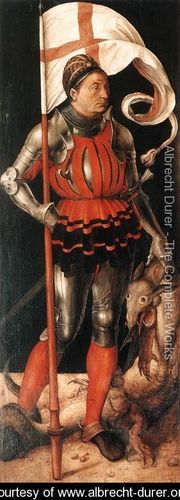
 Attachment: 66.23 KB Attachment: 66.23 KB
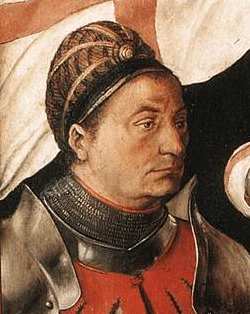
Chief Librarian/Curator, Isaac Leibowitz Librarmoury
Schallern sind sehr sexy!
|
|
  |
 |
|
Lafayette C Curtis
|
 Posted: Wed 25 May, 2011 11:19 pm Post subject: Posted: Wed 25 May, 2011 11:19 pm Post subject: |
 |
|
|
Have we paid enough attention to the possibility that the caul/cap could be both a military foundation garment and a civilian fashion accessory? I've been known to wear a newsboy cap with my hair stuffed inside underneath a modern combat helmet on one occasion, and under a sallet in another (when there was nobody around who'd look inside the helmet), and we have images of soldiers wearing American patrol caps underneath their helmets in World War II, the Korean War, and some of the small wars early in the Cold War. I know a direct extrapolation isn't always warranted but I wouldn't be surprised if medieval fighting men really treated the caul as a dual-purpose accessory in this manner.
|
|
  |
 |
Mark T

|
 Posted: Thu 26 May, 2011 1:43 am Post subject: Posted: Thu 26 May, 2011 1:43 am Post subject: |
 |
|
Hi Lafayette,
Yes, I wondered a similar thing in an earlier post ... whether an 'arming caul' (for want of a better term) would have also been able to serve duty as a 'fashion caul', I don't know. However, I was wondering if it might have more been a case of the two mirroring each other - think doublet and arming doublet.
I think we're now all just sitting back and waiting to see if there's any more hard evidence one way or another. To me, the pictorial images so far suggest this could well be plausible, but I think we need some textual evidence for more solid confirmation, or perhaps find out what Gerry's latest thinking is on this, as it sounds like he might be the sole modern source of where some of us have picked up this idea as 'fact', and now just want to confirm it ...
Before we all go out and buy ourselves some highly-fashionable hair nets!
Why do I do this again? 
Chief Librarian/Curator, Isaac Leibowitz Librarmoury
Schallern sind sehr sexy!
|
|
  |
 |
Sean Flynt

|
|
   |
 |
Sean Flynt

|
 Posted: Fri 27 May, 2011 7:10 am Post subject: Posted: Fri 27 May, 2011 7:10 am Post subject: |
 |
|
Here's my best shot.  Consider the two Italian paintings below. The first is by Carpaccio. The second, by Morando, is the source of one of the Ffoulkes illustrations. Consider the two Italian paintings below. The first is by Carpaccio. The second, by Morando, is the source of one of the Ffoulkes illustrations.
In both paintings we see (probably) a nobleman in armour with a nearby squire or other retainer wearing the elements of armour typically placed on the body last and removed first--the throat and head defense.
The Carpaccio piece is helpful just to confirm that a retainer might wear his master's armour rather than simply carry it.
The youthful retainer in Morando's painting holds a lance and wears a reinforced and pointed arming garment with full, slashed and gathered sleeves. He also wears what appears to be the main figure's blued and gilded throat defense. His long hair is gathered atop his head in what appears to be nothing more than an unadorned bleached linen bag. It has all the appearance of undergarments of the period as opposed to the complex and richly decorated nets and caps we've been talking about so far.
Given the Carpaccio painting as reference, one could interpret this as meaning that the retainer is meant to wear his master's throat defense and helmet, and carry his lance, until needed. He wears the cap and, perhaps, gives it to his master before the exchange of armour.
The argument against--Hair as long as the Morando knight's could theoretically interfere with arming the body. It might have been useful to gather the hair for arming the body and free it before arming the throat and head. Against that argument, though, is the conspicuous absence of art historical evidence for long hair flowing from the back of the helmet.
 Attachment: 194.77 KB Attachment: 194.77 KB
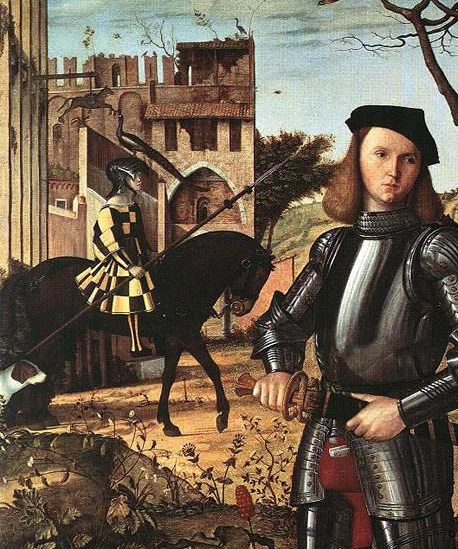
 Attachment: 237.37 KB Attachment: 237.37 KB
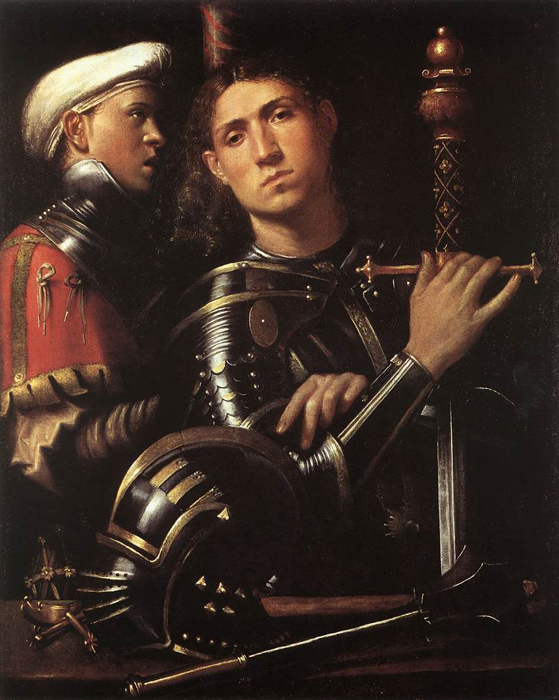
-Sean
Author of the Little Hammer novel
https://www.amazon.com/Little-Hammer-Sean-Flynt/dp/B08XN7HZ82/ref=sr_1_1?dchild=1&keywords=little+hammer+book&qid=1627482034&sr=8-1
|
|
   |
 |
|
Craig Shackleton
|
|
   |
 |
Mark T

|
 Posted: Fri 27 May, 2011 3:27 pm Post subject: Posted: Fri 27 May, 2011 3:27 pm Post subject: |
 |
|
Hi Craig,
Thanks for those images! The second from Dürer is already above, but I'll post two versions of the detail from Craig's first one below. This is Dürer's 'Die Anbetung der Heiligen Dreifaltigkeit' or 'The Adoration of the Trinity' (The Landauer Altarpiece), 1511.
It's a little hard to make out in these images below, but in the printed version in Waffen und rüstungen (p. 102), the actual construction of the net can clearly be seen - as in the image of St George from the Paumgartner Altarpiece above.
This is another fantastic example of someone being fully armoured, except for the helm, and wearing a caul.
Thanks again for the lead, Craig ... I've also noticed a few more cauls in W&R now, so will try to upload them soon.
 Attachment: 55.67 KB Attachment: 55.67 KB
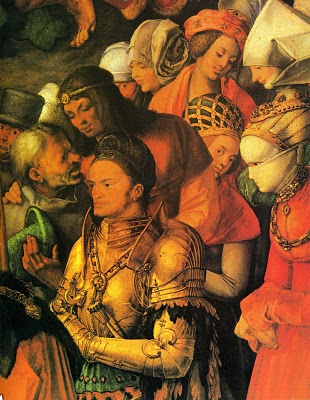
 Attachment: 85.81 KB Attachment: 85.81 KB
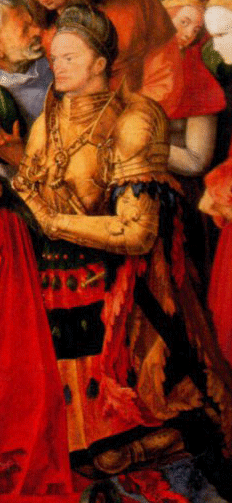
Chief Librarian/Curator, Isaac Leibowitz Librarmoury
Schallern sind sehr sexy!
|
|
  |
 |
Mark T

|
 Posted: Fri 27 May, 2011 4:41 pm Post subject: Posted: Fri 27 May, 2011 4:41 pm Post subject: |
 |
|
Hi Sean,
Thanks for those additions to this (to me, at least!) fascinating conversation. And thaks for the Morando image that Ffoulkes cited; I had been meaning to track that down. (What great detail on the arming garment! I'm not sure I've seen this before in any of our conversations about arming garments here.)
Those are some interesting questions about the role of the retainer. I wonder if a retainer/squire would have worn something as 'personal' as their master's caul? At the very least, we still have some more sources that show cauls in a context of armour / arming.
However, I was really drawn to this point:
| Sean Flynt wrote: | | ... the conspicuous absence of art historical evidence for long hair flowing from the back of the helmet. |
I think this is critical in our current discussion overall: we see contemporaneous images of armoured men with long hair, but when helmets are on, we don't tend to see images of that hair outside of the helmet. Therefore, this really begs the question of how that hair was contained within the helmet. Speaking from experience, and I'm sure Blaz will agree, even a full helmet liner which is linen-lined and padded (and therfore has the friction of both pressure and linen's surface texture) does not do this effectively - you need a coif, a fringed hood, or a caul-like object (hence the use of 'secret beanies' worn under helms by some reenactors).
| Sean Flynt wrote: | | His long hair is gathered atop his head in what appears to be nothing more than an unadorned bleached linen bag. It has all the appearance of undergarments of the period as opposed to the complex and richly decorated nets and caps we've been talking about so far. |
This is a great example - and possibly helps in the case for the idea of simple ones worn under helms (and, in some images, under more fancy hats) in addition to more elaborate cauls that look like they were worn for fashion.
We have touched on simple caps before:
| Mark T wrote: | | From the images, we see that some aren't so fancy: either simple hair nets - almost exactly the same as those under helmets in different physical pursuits today, such as horseriding - or small, flat caps ... |
To add to this growing 'imagebank', I'll add two more pics here: the first is of a plain, 'full fabric' caul that Gwen sent me (I don't have any source information for it). The second is of Ulrich Varnbuler, by Dürer (1522), and shows what looks like a comparatively plain caul under his hat (similar to the Dürer image of Melchior Pfinzing I posted on the previous page).
Given that we do have pictorial evidence that cauls were worn under hats, while this is not proof that they were worn under helms, it does tells us two things: first, some cauls were made to be hidden / were not fashion items, second, they presumably worked at keeping hair out of the way when under another headcovering: they contained the hair, and compressed enough to fit under hats. In this context, I can see how they would have been practically effective under helmets - and also find it hard to believe that people would not have tested this, and then done it (assuming that the 'civilian/fashion' caul came first, rather than the other way around ... and assuming they were even two separate things!).
Great stuff!
 Attachment: 190.86 KB Attachment: 190.86 KB
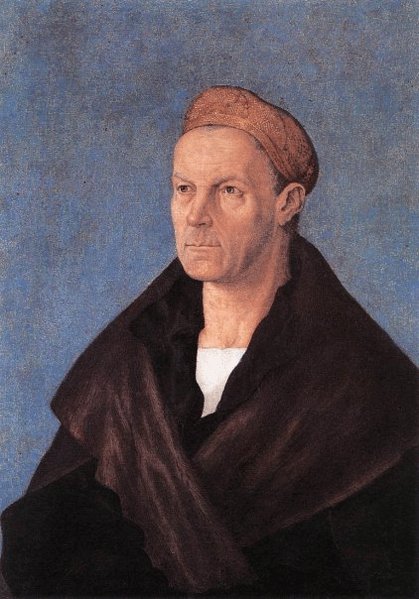
Image courtesy Gwen Nowrick
 Attachment: 80.07 KB Attachment: 80.07 KB
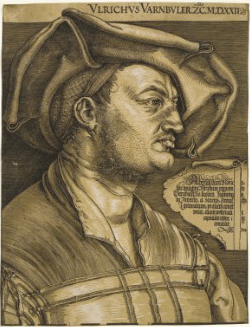
Ulrich Varnbuler, Albrech Durer 1522
Chief Librarian/Curator, Isaac Leibowitz Librarmoury
Schallern sind sehr sexy!
|
|
  |
 |
Mark T

|
 Posted: Fri 27 May, 2011 4:54 pm Post subject: Posted: Fri 27 May, 2011 4:54 pm Post subject: |
 |
|
Here's another, from 'Matryrium des hl. Sebastian' / 'The Martyrdom of Saint Sebastian', the middle panel of the 'Sebastian Altarpiece', by Hans Holbein the Elder, 1516.
This one is rendering a little darkly; it's printed in Waffen und Rüstungen on p. 41, and has fantastic detail there.
 Attachment: 199.21 KB Attachment: 199.21 KB
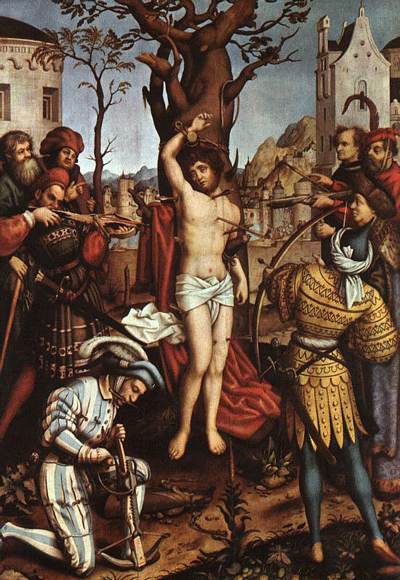
 Attachment: 48.05 KB Attachment: 48.05 KB
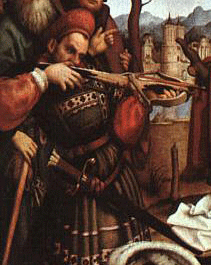
Chief Librarian/Curator, Isaac Leibowitz Librarmoury
Schallern sind sehr sexy!
|
|
  |
 |
Mark T

|
 Posted: Sat 28 May, 2011 1:54 am Post subject: Posted: Sat 28 May, 2011 1:54 am Post subject: |
 |
|
Going back over Albrecht Dürer, Waffen und Rüstungen, I realised we hadn't yet posted one of the best examples - although, in this case, one that is being worn without a helmet: Dürer's 'Ritter und Landsknecht' (1496-97):
 Attachment: 115.12 KB Attachment: 115.12 KB
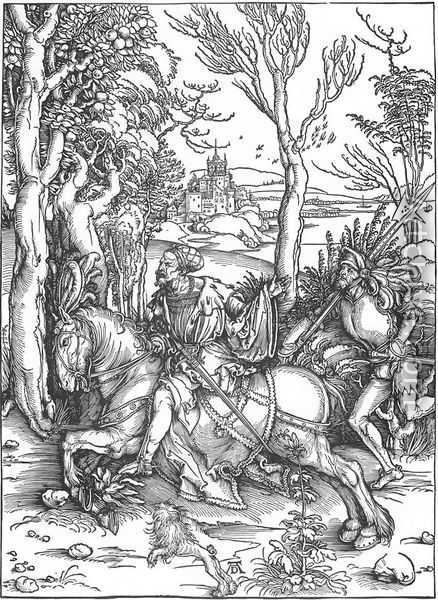
 Attachment: 37.11 KB Attachment: 37.11 KB
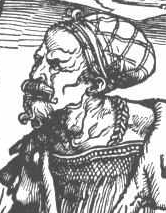
Chief Librarian/Curator, Isaac Leibowitz Librarmoury
Schallern sind sehr sexy!
|
|
  |
 |
|
Craig Shackleton
|
 Posted: Sat 28 May, 2011 7:53 am Post subject: Posted: Sat 28 May, 2011 7:53 am Post subject: |
 |
|
The thing I found most interesting in going through Waffen und Rustungen, and particularly the one image above, is that I could not find one instance there of someone in civilian clothes wearing the caul/hairnet. The large image has so many people in it wearing different types of headwear, and only the armoured figure has the caul.
It appears to me that Durer at least associated that hat with armour and/or soldiers/warriors.
Ottawa Swordplay
|
|
   |
 |
Mark T

|
 Posted: Sat 28 May, 2011 4:02 pm Post subject: Posted: Sat 28 May, 2011 4:02 pm Post subject: |
 |
|
Hi Craig,
Yes, it's great to have so many examples of cauls in contexts of armour / war. However, I think that's more an outcome of the focus of the book ('Waffen und Rüstungen' = 'Arms and Armour'), rather than a particular take Dürer might have had about cauls, or about them only being found in armed contexts:
- We have many examples of cauls worn in civilian contexts, including by Düruer - see the images of Fugger, Pfinzing, and Varnbuler above. (While Fugger, and possibly Varnbuler, have points on their doublets, it's unclear from the context whether these are dedicated arming garments, or civilian ones following that fashion, as Sean noted above.)
- We also have the two colour images above supplied by Gwen, showing cauls as fashion items.
- There are also quite a few images clearly showing a caul under a civilian hat.
- Conversely, we do have some images of men in armour / war contexts, but with a civilian hat on their heads (throughout 'Waffen und Rüstungen'; see also Das Mittelalterlishce Hausbuch, among other sources).
- Finally, we have a lot of images of women wearing cauls, both on their own as fastion items, and plainer nets worn under hats.
So we know that cauls were definitely worn not only in civilian contexts, but also as items of fashion.
The outstanding question is whether they were definitely worn under helmets ... so far, to support this we have:
- the claims of Ffoulkes, which are tricky given the hazards and limitations of much else of his work, and that he doesn't give a source, save for citing some of the images above, which are not proof of this use
- Embleton's statement of the case (again uncited, although the Paumgartner Altarpiece served as a source for one of his drawings ... whatever weight his statements might otherwise carry - after all, he and other members of the CSG and other groups who've appeared in his books have been the first ones to point out some of their own mistakes, anachronisms, and so on - which is why I'm really hoping some CSG folks might join this discussion)
- Some pretty good arguments we've all made during this thread.
For the last, these seem to me:
- Sean's point that contemporaneous images will show men with long hair when exposed, but without this hair showing (and therefore under the helmet) when helmeted.
- Therefore, the need for some way / item to contain hair, given that helmet liners are not sufficient (as shown by modern experimentation)..
- Extrapolation / context of other modern physical pursuits involving helmets also using hairnets, such as horseriding.
- The 'common sense' argument that if cauls first existed as a ciivilian item, and were used under hats (which we do have evidence for), then it would make sense for people to have seen they would be worth trying under helmets - and would have found them to work. Even without solid proof, this point enough seems like a good case for a verdict of 'historically plausible' to me
- Images that show cauls in contexts that appear to be in an arming, 'de-arming', or display of armour context (Morando and Carpaccio).
- Images that show men who, presumably, have only very recently just removed their helmets (the execuation / martyrdom of St Florian, above, and Albrecht Dürer's 'Der heilige Georg zu Fuß', 1502/1503.
To me, these points make a pretty good circumstantial case to support Ffoulkes and Embleton ... I'd like just one example of actual solid proof so we can put this to bed! 
PS I've just written to Christian Folini at The Company of St George, to see if they might be able to offer any recent reflections or research, seeing as the topic of cauls did not appear in their recent clothing guide for men.
Chief Librarian/Curator, Isaac Leibowitz Librarmoury
Schallern sind sehr sexy!
|
|
  |
 |
Sean Flynt

|
|
   |
 |
Sean Flynt

|
|
   |
 |
Thomas R.

|
 Posted: Mon 06 Jun, 2011 9:11 am Post subject: Posted: Mon 06 Jun, 2011 9:11 am Post subject: |
 |
|
I guess, thoses hairnets were not used as some sort of extra-padding under a helmet. This interpretation seems to me very biased. My best guess in this topic is, that the nets were used in warm weather to hold the long hair back and free the wearer's neck from sweaty hair. Ponytails may have been considered as womanly, so other means of holding the hair back had to be found. And since long hair may have been seen as signs of strength and youth, even old men without much hair would have adopted the nets as a fashion. So the pictures could be worth a second look, keeping the depicted season in mind. Are there any wintertime pictures with hairnets shown?
Just my two cents,
Thomas
http://maerenundlobebaeren.tumblr.com/
|
|
   |
 |
Sean Flynt

|
 Posted: Mon 06 Jun, 2011 11:49 am Post subject: Posted: Mon 06 Jun, 2011 11:49 am Post subject: |
 |
|
They're clearly meant only to gather the hair rather. There would be some padding effect but that seems to be uneccessary. So far I haven't seen much art historical evidence of hair protruding from a sallet in any weather, even at the height of the period in which long hair was considered a status symbol. There's an obvious reason for this we haven't mentioned much (at all?) in this thread. Germans valued combat wrestling skills. Why would a man essentially dangle a handle out of his helmet for an opponent to grab?
-Sean
Author of the Little Hammer novel
https://www.amazon.com/Little-Hammer-Sean-Flynt/dp/B08XN7HZ82/ref=sr_1_1?dchild=1&keywords=little+hammer+book&qid=1627482034&sr=8-1
|
|
   |
 |
Sean Flynt

|
 Posted: Mon 06 Jun, 2011 12:46 pm Post subject: Posted: Mon 06 Jun, 2011 12:46 pm Post subject: |
 |
|
It occurred to me that we're not finding the smoking gun we need because we're looking at images of soldiers in non-combat situations--there's always the possibility of a man taking the time to bind his hair after removing his sallet.
Battle scenes, on the other hand, often show decapitations and lost armour so I took a closer look at a few of the "Stammbaum der Babenburger" battle scenes from Imareal (ca. 1489). These are maddeningly low-res but they're approaching the smoking gun. The severed head, in particular, is compelling because we can be confident the fellow didn't remove his helmet and put on a caul in the midst of combat. Unfortunately, neither his body nor his helmet is evident here. My first thought was that this was meant to represent a Turk but there is no evidence of Turkish enemies in this miniature. The man at arms to the upper left of the head appears to have a red lining or caul exposed at his brow line. His sallet has red straps (you can see the typical "Y" shape,) so this might just be the edge of the lining band. The two figures in these images that could provide the ultimate evidence are obscured by damage. Both figures are mortally wounded, the sallets knocked off and close by. The man on the ground appears to be wearing a light-colored fabric head covering. The head of the man falling from his horse is either covered in blood or a red cap. All of these images are in the Austrian National Librar so the proof we seek may be within somebody's reach, assuming the originals are more legible than these low-res images.
We need to examine more depictions of battle in this period. The lost sallet is a common image. I think a survey of that artwork could at least confirm that cauls were worn under sallets in this period. The question of how widespread this was would remain, but we would have answered the basic question.
 Attachment: 246.19 KB Attachment: 246.19 KB
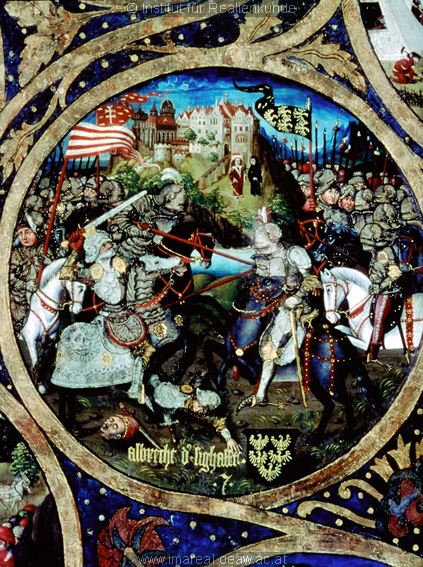
 Attachment: 233.49 KB Attachment: 233.49 KB
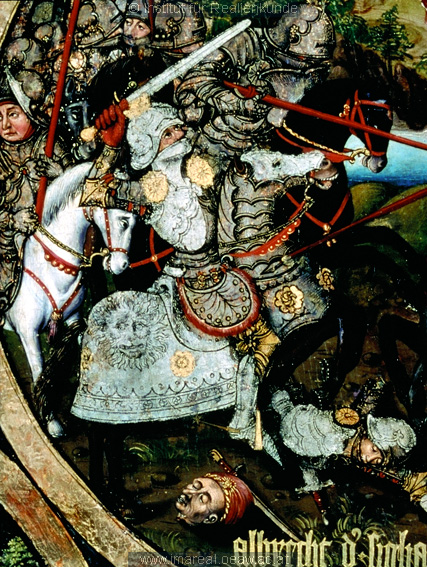
 Attachment: 225.49 KB Attachment: 225.49 KB
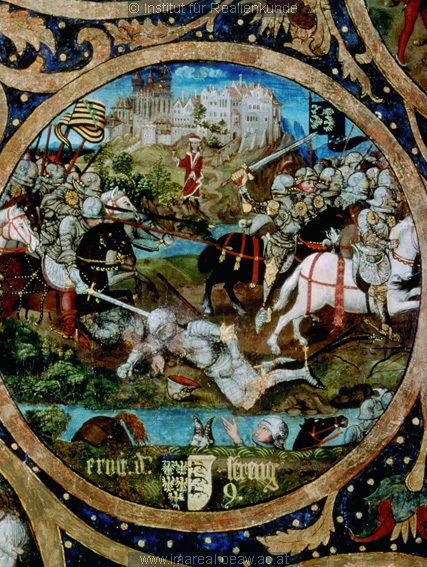
 Attachment: 239.1 KB Attachment: 239.1 KB
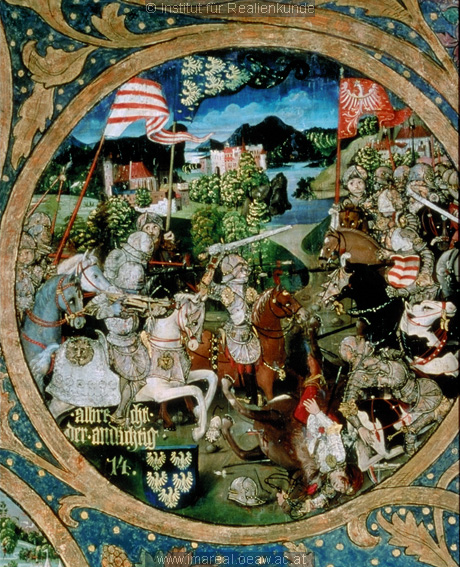
-Sean
Author of the Little Hammer novel
https://www.amazon.com/Little-Hammer-Sean-Flynt/dp/B08XN7HZ82/ref=sr_1_1?dchild=1&keywords=little+hammer+book&qid=1627482034&sr=8-1
|
|
   |
 |
|
Phil D.
|
 Posted: Mon 06 Jun, 2011 1:00 pm Post subject: Posted: Mon 06 Jun, 2011 1:00 pm Post subject: |
 |
|
Hey Sean,
In the closeup of the severed head pic(one in the middle)what is the knight on the left wearing under his helmet...see the red protruding from the sides and forehead from under his helmet.The helmet liner wouldn't be illustrated so visibly would it.
"A bottle of wine contains more philosophy than all the books in the world." -- Louis Pasteur
"A gentleman should never leave the house without a sharp knife, a good watch, and great hat."
|
|
  |
 |
Sean Flynt

|
 Posted: Mon 06 Jun, 2011 1:08 pm Post subject: Posted: Mon 06 Jun, 2011 1:08 pm Post subject: |
 |
|
| Phil D. wrote: | Hey Sean,
In the closeup of the severed head pic(one in the middle)what is the knight on the left wearing under his helmet...see the red protruding from the sides and forehead from under his helmet.The helmet liner wouldn't be illustrated so visibly would it. |
That's one of the figures I mentioned above. I see the typical "Y" strap there, plus material of the same color just above the brow. That could be the lining band or the lining itself. I'm not sure why the band would be dyed, though, as it's always covered by the liner. Could be a caul. Could be a hood.
-Sean
Author of the Little Hammer novel
https://www.amazon.com/Little-Hammer-Sean-Flynt/dp/B08XN7HZ82/ref=sr_1_1?dchild=1&keywords=little+hammer+book&qid=1627482034&sr=8-1
|
|
   |
 |
|
|
You cannot post new topics in this forum
You cannot reply to topics in this forum
You cannot edit your posts in this forum
You cannot delete your posts in this forum
You cannot vote in polls in this forum
You cannot attach files in this forum
You can download files in this forum
|
All contents © Copyright 2003-2024 myArmoury.com — All rights reserved
Discussion forums powered by phpBB © The phpBB Group
Switch to the Basic Low-bandwidth Version of the forum
|

